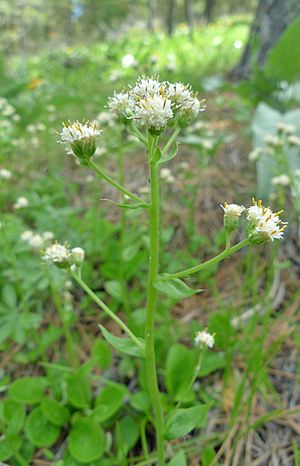Racemose pussytoes facts for kids
Quick facts for kids Racemose pussytoes |
|
|---|---|
 |
|
| Antennaria racemosa near Chumstick Mountain, Chelan County Washington | |
| Scientific classification | |
| Genus: |
Antennaria
|
| Species: |
racemosa
|
| Synonyms | |
|
|
Antennaria racemosa, also called racemose pussytoes, is a type of flowering plant. It belongs to the daisy family. This plant grows naturally in western North America. You can find it from British Columbia and Alberta in Canada, all the way south to northern California and Wyoming in the United States.
Contents
What is Racemose Pussytoes?
This plant is a perennial herb. This means it lives for more than two years. It can be small and fuzzy, or taller and almost smooth. Some plants grow up to 50 centimeters (about 20 inches) tall.
Leaves and Stems
Antennaria racemosa forms patches of oval-shaped leaves near the ground. These leaves are usually 3 to 10 centimeters long. The underside of the leaves feels fuzzy. The top side is a shiny green color.
The plant also has special stems called stolons. These stolons creep along the ground. They are covered in leaves and connect the different patches of the plant.
Flowers and Seeds
A tall stem grows upwards from the plant. This stem holds the flowers. The flowers grow in a group called an inflorescence. This group often looks like a raceme, which means the flowers are arranged along a central stem. Each plant has several small flower heads.
Interestingly, Antennaria racemosa has separate male and female plants. The male plants produce one type of flower. The female plants produce another type.
After the flowers bloom, the plant produces fruit. Each fruit is a tiny achene. It is only about a millimeter long. Attached to the achene is a soft, feathery part called a pappus. This pappus is like a tiny parachute. It helps the seed catch the wind. The wind then carries the seed away to a new spot. This is how the plant spreads its seeds.
How Racemose Pussytoes Grows
This plant likes to grow in mountain forests. It prefers places that are moist and partly shaded. You can often find it growing in bare patches of soil. It especially likes soil that is rich in minerals. This includes areas where the ground has been disturbed, like after a landslide.
Besides spreading seeds by wind, Antennaria racemosa also spreads in another way. It uses its creeping stolons. These stolons grow along the ground. New plants can sprout from these stolons. This is called vegetative reproduction. It means the plant can make copies of itself without needing seeds.

